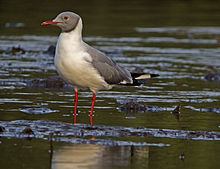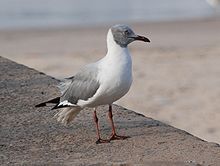- Grey-headed Gull
-
Grey-headed Gull 
Breeding adult, Senegal Conservation status Scientific classification Kingdom: Animalia Phylum: Chordata Class: Aves Order: Charadriiformes Family: Laridae Genus: Chroicocephalus Species: C. cirrocephalus Binomial name Chroicocephalus cirrocephalus
(Vieillot, 1818, Brazil)Synonyms Larus cirrocephalus
The Grey-headed Gull (Chroicocephalus cirrocephalus) is a small gull which breeds patchily in South America and Africa south of the Sahara. It is not truly migratory, but is more widespread in winter. This species has occurred as a rare vagrant to North America and Spain. It is also known as the Grey-hooded Gull. As is the case with many gulls, it has traditionally been placed in the genus Larus.
This locally abundant gull breeds in large colonies in reedbeds and marshes, and lays two or three eggs in a nest that can be on the ground or floating. Like most gulls, it is highly gregarious in winter, both when feeding or in evening roosts. Although it is predominantly coastal or estuarine, it is not a pelagic species, and is rarely seen at sea far from land.
Flocks numbering hundreds or thousands of these gulls can form when the feeding conditions are appropriate.
The Grey-headed Gull is slightly larger than the Black-headed Gull at 42 cm length. The summer adult has a pale grey head, a grey body, darker in tone than the Black-headed, and red bill and legs. The black tips to the primary wing feathers have conspicuous white "mirrors". The underwing is dark grey with black wingtips. The grey hood is lost in winter, leaving just dark streaks.
Sexes are similar. The South American race is slightly larger and paler-backed than the African subspecies. This gull takes two years to reach maturity. First year birds have a black terminal tail band, and more dark areas in the wings.
In flight, the wings are broader and held flatter than those of Black-headed Gull.
This is a noisy species, especially at colonies. The call is a raucous crow-like caw, caw.
The rare species was just recently found at Coney Island on August 1st, 2011. Scientist say this is extremely rare as it only breed in parts of Africa.
References
- ^ BirdLife International (2004). Larus cirrocephalus. 2006. IUCN Red List of Threatened Species. IUCN 2006. www.iucnredlist.org. Retrieved on 5 May 2006. Database entry includes justification for why this species is of least concern
- Seabirds by Harrison, ISBN 0-7470-1410-8
- Birds of The Gambia by Barlow, Wacher and Disley, ISBN 1-873403-32-1
- Pons J.M., Hassanin, A., and Crochet P.A.(2005). Phylogenetic relationships within the Laridae (Charadriiformes: Aves) inferred from mitochondrial markers. Molecular phylogenetics and evolution 37(3):686-699
Gulls (family: Laridae) Genus Larus Pacific Gull • Belcher's Gull • Olrog's Gull • Black-tailed Gull • Heermann's Gull • Common Gull (or Mew Gull) • Ring-billed Gull • California Gull • Great Black-backed Gull • Kelp Gull (or Cape Gull) • Glaucous-winged Gull • Western Gull • Yellow-footed Gull • Glaucous Gull • Iceland Gull • Kumlien's Gull • Thayer's Gull • European Herring Gull • Heuglin's Gull • American Herring Gull • Yellow-legged Gull • Caspian Gull • Vega Gull (or East Siberian Gull / Mongolian Gull) • Armenian Gull • Slaty-backed Gull • Lesser Black-backed GullIchthyaetus Leucophaeus Chroicocephalus Silver Gull • Red-billed Gull • Huahine Gull • Hartlaub's Gull • Brown-hooded Gull • Grey-headed Gull (or Grey-hooded Gull) • Andean Gull • Black-billed Gull • Brown-headed Gull • Black-Headed Gull • Slender-billed Gull • Bonaparte's GullSaundersilarus Hydrocoloeus Rhodostethia Rissa Pagophila Xema Creagrus Categories:- IUCN Red List least concern species
- Gulls
- Chroicocephalus
Wikimedia Foundation. 2010.


